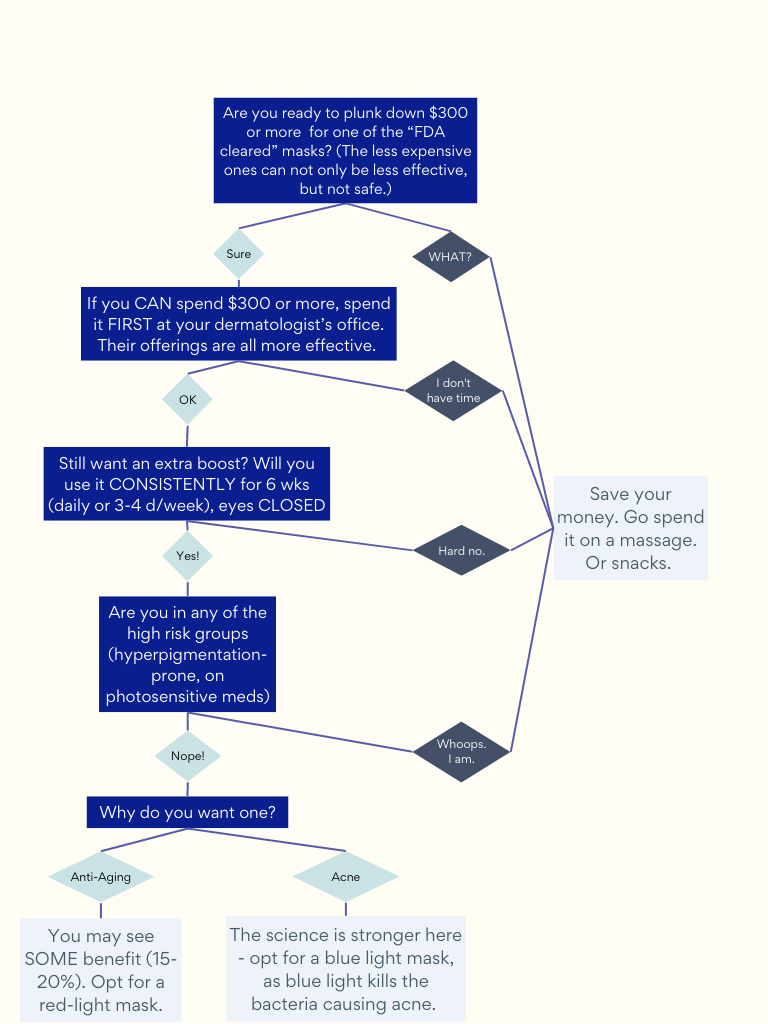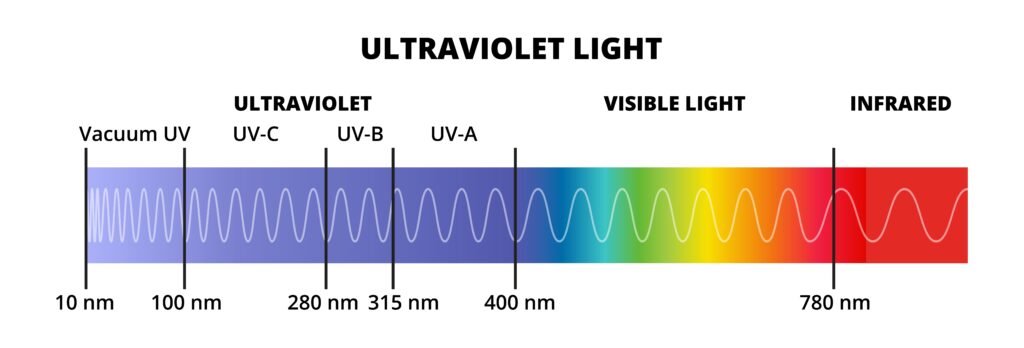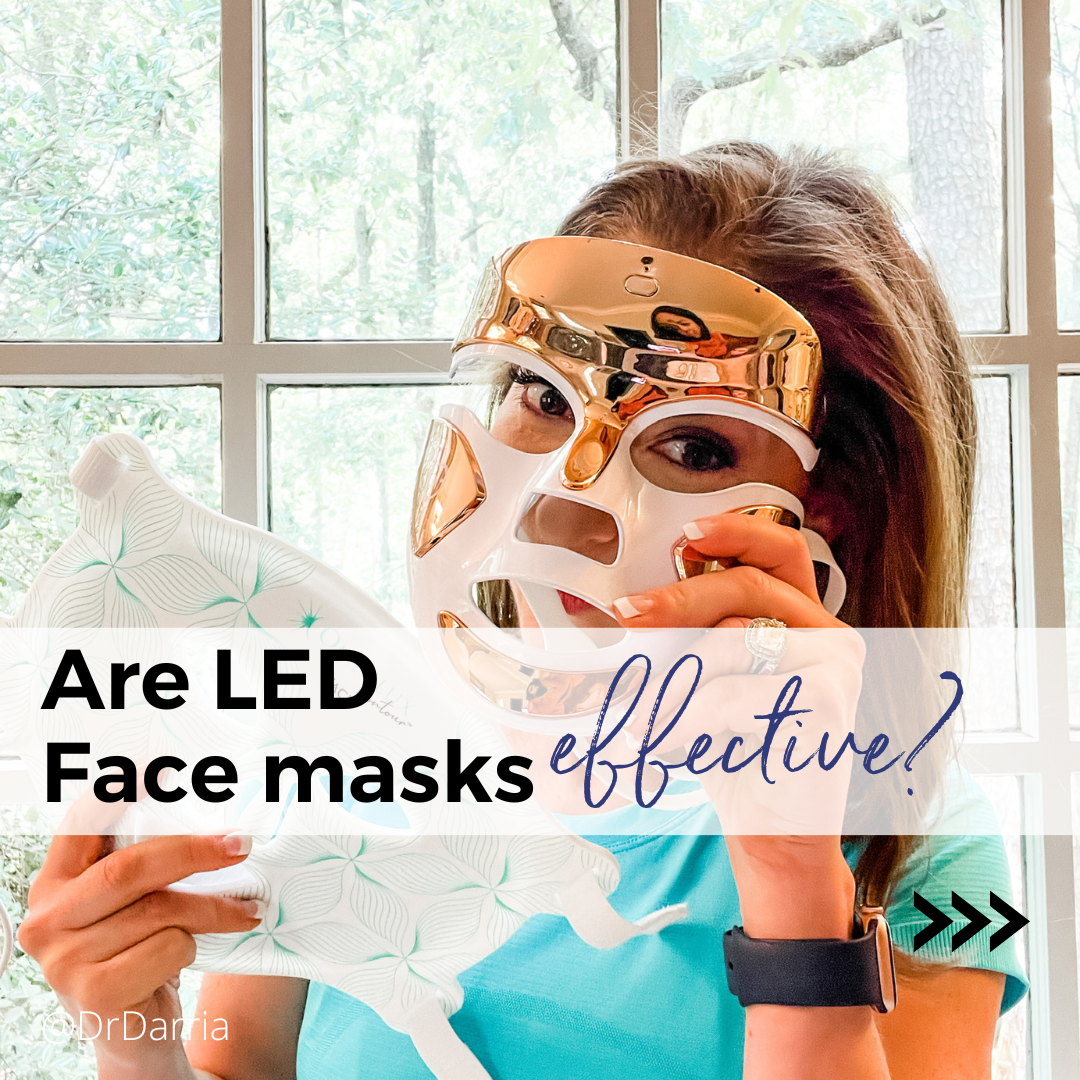Q: Are LED face masks as effective as social media claims?
Can we truly get baby smooth skin from LED face masks ? (great Q – thank you for submitting!).
Several of you seemed intrigued by those Star-Wars-appearing LED masks – and wanted to know if they worth the money. We were intrigued, too (we always love a good beauty tip)!
Here’s what we found.
Bottom Line, TL;DR
(for more details, check out the FULL Report!)
Acne:
- The science: The data quality was pretty good here: blue light kills acne-causing bacteria, reducing inflammation + redness – especially for inflammatory acne (pustules).
- When do use: It’s not a standalone cure, but it can give an extra boost if you aren’t fully improved with standard therapies. In some cases, it can prevent you from having to go on systemic medications (like antibiotics).
- Caveat: The effect only lasts as long as you keep using it.
- Risks: Blue light comes with risks (more than red light), including hyperpigmentation, possible photo-aging (yikes – this conveniently doesn’t get mentioned…), and possible retinal damage so read the full Risks section below before purchasing.
Which mask we’d choose for acne: Dr. Dennis Gross SpectraLite FaceWare Pro
Anti-Aging:
- The science: The science isn’t AS strong as for blue light, but red light reduce inflammation and increase collagen synthesis, cell growth, and blood flow. Expect 10-25% improvement in skin elasticity, roughness, and softness of fine lines. HOWEVER, the research for these was funded primarily by manufacturers, in *ideal* conditions (like using microdermabrasion before the mask), so it’s hard to know the actual real-world efficacy.
- Efficacy: Red light masks are LESS effective than in-office dermatology treatments (ie lasers, peels) or Retinoic Acid. However, they’re probably as effective (or more) than most other OTC products. (ie: maybe buy the mask, before that $$$$ lotion).
- Use when:
- You’re already using Retinoic Acid + procedures at your derm and want extra boost
- You don’t want to go to the derm, want a little more oomph in your skin, and can use this consistently for 6 weeks.
- Risks: Red light doesn’t come with the same photo-aging or hyperpigmentation risks as blue light, but still some risks can exist, including possible retinal damage (see Risks).
Which mask we’d choose for anti-aging: Omnilux Contour FACE or the Dr. Dennis Gross SpectraLite FaceWare Pro (on red light setting)
CAUTION: If you buy a mask (especially a non-FDA cleared one), and it gets HOT, it’s NOT working correctly! Return it.
Our Handy "led mask decision tree"
(for more details, check out the FULL Report!)

TrueveLab Report
HOW LED FACE MASKS WORK
First of all, in case you don’t talk about light wavelengths in your everyday, it may be helpful to just describe the science here. When we talk about light and skin, you’re likely most familiar with the “ultraviolet” light, namely UVA and UVB (See Image). These trigger photo-aging, burns, and skin cancer through oxidative stress and DNA damage to the skin.
LED masks specifically emit light in the VISIBLE LIGHT range; we’ll focus today on blue and red, since those are the most commonly in use for masks right now.
- Red light’s longer wavelength penetrates deeper into the skin, facilitating regeneration of the skin structure.
- Blue light has a shorter wavelength, meaning it penetrates less deeply, and works for conditions in the superficial layer, such as acne.
- NOTE on blue light – the sun emits blue light, which causes oxidative stress. Whether the blue light emitted from LED masks can cause the same stress isn’t 100% clear, but it does appear to be a risk.
- In contrast, UV Light emits very short wave light, which induces oxidative stress and DNA damage, leading to aging, burns, and cancer.

A Note on the Evidence
- The evidence for these masks is fairly soft – and mostly carried out by the mask manufacturers. That’s not uncommon – and doesn’t mean it’s not useful, simply that it’s harder to assess the true potency of the product.
- Much of the research was done in vitro – i.e. in test tubes vs. in vivo, on skin.
- Many studies were done with protocols that include microdermabrasion or other exfoliation prior to each treatment, protocols we may not do in “real world” scenarios.
Benefits of LED Face Masks
Acne
- Overall: When looking at the commercial uses for LED masks, the evidence for their benefit is strongest in acne– particularly for inflammatory acne (i.e. pustules).
- Mechanism:
- Acne is caused by a bacteria, Propionibacterium acnes. Exposure to blue light induces oxidative stress that kills the bacteria and reduces blockage of the follicle. It also decreases oil gland proliferation and inflammation. Adding red light can further improve benefits.
- Results:
- Studies show a reduction in lesion size, number, and redness. Reduces oil gland proliferation and decreases inflammation. (Goldberg and Russel 2006)
- One study of 30 patients showed that while there was no significant difference at 5 weeks, after 8-12 weeks of consistent use, lesion counts had fallen by 50-60% – which is why these treatments require patience. (Ablon).
- Studies show a reduction in lesion size, number, and redness. Reduces oil gland proliferation and decreases inflammation. (Goldberg and Russel 2006)
According to Dr. Darren Casey, a dermatologist at Atlanta Dermatology, “I’ve had some luck [using a blue LED light] with patients with acne, if used in conjunction with other anti-acne care, and used consistently. In patients for whom many therapies have failed, it can be useful, and for instance, in some can mean that a patient can stop taking an oral antibiotic.”
- Caveat:
- These masks must be used both consistently and continuously. If you stop using the mask, acne can return.
- Results are best when combined with other therapies for exfoliation prior to LED light exposure (Ablon)
- Risk: (see below)
Anti-Aging
Overall: Compared to the benefits for acne from LED light, the evidence for anti-aging is not as strong.
- Mechanism:
- In vitro studies show that red LED can activate fibroblast growth factor, increasing collagen synthesis, blood vessel formation, cell proliferation, and increased blood flow. (Barolet 2009). (Kim et al 2020)
- While most anti-aging therapies work by inducing trauma to the skin, thereby stimulating growth, red LED induces change through a process known as photo-biomodulation, which does not require thermal injury.
- Results:
- One split-face study funded by the mask manufacturer showed a reduction in roughness (around 33%), reduced skin furrows, fewer signs of aging, softening of some wrinkles. (Russell et al 2005), and increase of elasticity by about 19% (Lee, SY et al) (Wunsch)
Dr. Whitney Bowe, dermatologist and founder of Dr. Whitney Bowe Beauty, noted, “These at home devices can provide subtle changes especially if used consistently over time. If someone desires a more dramatic change in a shorter period of time, in-office procedures are going to be far more effective at delivering those results.”
- Pro tip: exfoliate prior to using the mask or apply a serum using antioxidants or other active ingredients, to increase the impact of the mask.
Risks of LED Face Masks
Hyperpigmentation: Blue light can stimulate melanocytes, causing increased pigment production (Regazzetti). Be cautious and speak with your dermatologist first if you:
- Have darker skin
- Are prone to hyperpigmentation – i.e. more likely to develop sun spots or dark spots after acne
- Are on medications that cause photosensitivity (such as doxycycline)
- Have a photosensitivity disorder (such as lupus)
- If you have melasma
- Are pregnant
Eye damage: While some mask instructions permit having eyes open while wearing, we strongly discourage this practice (as did all of the dermatologists we interviewed). High energy blue light can cause retinal damage. One case report was written about a patient who used her mask as instructed while doing routine tasks, and experienced retinopathy, or damage to her retina. If you’re going to use these masks, do so with your eyes closed and protected.
Low Quality Machines: Product warning – there are many products on the market that claim to be LED, but are not. If your device gets hot, it’s NOT LED, which should not produce any heat. If that happens, stop using it ASAP. For instance, we found one product that noted a “working temperature” of 107-114 F. That’s a RED FLAG – do not buy any product that generates heat.
Photo-Aging: Blue light can induce oxidative stress and photo-aging, making it feasible that the blue light from an LED mask could have a similar effect – something that concerned us in a product created for anti-aging.
We emailed Dr. Dennis Gross, whose company makes an LED mask that has both red and blue light, to inquire about the risk of photo-aging from blue light. Dr. Gross himself took the time to respond, and I wanted to share that here –
“Blue light from the sun (UVA) and uncontrolled high energy visible (HEV), which can be from electronic devices, have an unstable charge that acts as free radicals, damaging the skin’s collagen structure. However, controlled blue light set to a specific wavelength can actually be used to treat acne and is incorporated in many dermatology practice and at-home devices. The blue LED light used in my DRx SpectraLite technology is a controlled, timed treatment at exactly 415mn for three minutes. This wavelength has been clinically studied to kill P.acnes bacteria without damaging the skin. The key is to control the light, ensuring it doesn’t vary in intensity or fluctuate exposure.” – Dr. Dennis Gross
Bottom Line on Blue Light: We’d proceed cautiously here, due to the potential risk for blue light. We’d also opt for one that has both red and blue light – and use the blue only as necessary, to balance the benefits of reducing acne against the risk of inducing oxidative stress. If you were to purchase a mask for acne, we’d suggest Dr. Gross’ mask, due to their additional attention to this aspect of blue light.
SHOULD I BUY THE FDA APPROVED ONE? WHAT DOES THAT MEAN?
Some LED masks are “FDA Cleared” (such as products by both Omnilux and Dr. Dennis Gross). While this is good, this is VERY different from a product being “FDA Approved.” These are FDA CLEARED, not APPROVED.
FDA Cleared means that the manufacturer has demonstrated that the device is “substantially equivalent” to something that is already on the market – and thus does not need additional testing to be cleared. Is having FDA clearance better than none? Definitely – because the company has had to go through some regulatory process, submit data, and may have ongoing scrutiny. So, while the FDA Cleared label is not a safety or efficacy guarantee, if you buy one, opt for an FDA cleared – and if a site says “FDA Approved”, RUN, because that’s likely false.
HOW DOES THIS COMPARE TO IN-OFFICE THERAPIES OR OTHER ANTI-AGING THERAPIES?
Every dermatologist with whom we spoke – and the data we studied – backs up that there are OTHER, more effective therapies for both acne and anti-aging. In-office treatments will be able to be much stronger and produce results more quickly, and other topical therapies (Retinoic acid, for one) have much more evidence backing their efficacy.
When should you consider an LED face mask?
If you’re already doing ALL the other therapies, and you want to see more improvement (and are game to do so consistently), OR if you just don’t have the time to make it in for in-office therapies, but want a little boost.
Dr. Jeffery Dover, of Skincare Physicians of Chestnut Hill, says “If someone desires a more dramatic change in a shorter period of time, in-office procedures are going to be far more effective at delivering those results.”
When should you consider an LED face mask?
- Omnilux Contour Face ($395) –
- Red light therapy for skin rejuvenation
- Protocol: Three to five 10-minute sessions per week, for 4-6 weeks, followed by maintenance as desired
- PROS: Less expensive, and a flexible mask that makes modifying to your face easier (and slightly greater area covered)
- CONS: requires 10 minutes / session
- Omnilux CLEAR ($395) –
- Red and blue light for acne, inflammation, and redness
- Protocol: Four 10-minute sessions per week for six weeks, then at the earliest signs of a breakout after initial treatment.
- Dennis Gross – DRx Spectralite FaceWare Pro ($435) –
- Red, blue, and amber light for wrinkles and acne
- Protocol: Use treatment daily for 3 minutes
- Continue use for optimal results
- PROS: only 3 minutes a day makes this super-easy to include in your routine
- CONS: more costly, may not fit all face types as well because not flexible
- Other masks that we did NOT investigate ourselves, but have FDA-cleared designation, include:
- Shani Darden by Déesse PRO LED Light Mask ($1,900)
- MZ Skin LED 2.0 LightMAX Supercharged LED Mask ($818)
- Not sure if a mask you’re looking at is really FDA cleared? Look it up in the search space direct from the FDA here.
****Note – this list is by no means exhaustive of all FDA-cleared masks, nor is it an endorsement of these specific products.
Bottom line on LED Face Masks: Want to try one? As long as you are aware of the risks (and follow the recommended guidelines to protect yourself), AND have a reasonable expectation of effects, then go for it.
BUT – before you use your money (and time!) on one, consider trying these things first:
- Retinoic acid (either OTC or prescription)
- In-office treatments (your dermatologist has a slew of therapies with greater efficacy, including laser therapy, micro-needling, and peels).
Questions? Let us know!
All my best,
- Dr. Darria








